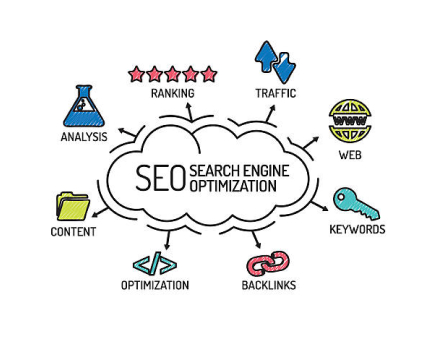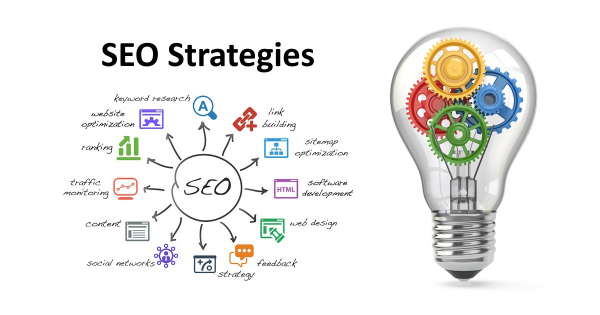What is SEO Marketing? Secrets to Website Optimization
Discover the significance of SEO in digital marketing and learn how to enhance your website’s SEO strategy.

SEO stands for Search Engine Optimization. It is a digital marketing practice that focuses on optimizing your website and its content to increase visibility on search engines like Google.
When someone searches for information, such as "data analyst salary" or "what is content marketing," an SEO-optimized website with relevant content will rank higher on the search engine results page (SERP). By improving your site for SEO, you help internet users find your content, products, and services organically, without relying on paid advertising.
In this article, we will explore SEO marketing, its importance, and how to get started with effective SEO strategies.
What Is SEO Marketing?
In today’s digital world, having an online presence is essential for any business. An effective SEO marketing strategy helps search engines like Google and Bing "crawl" your content and assess how it should rank on search engine results pages (SERPs).
SEO generally falls into three main categories:
On-page SEO focuses on the content of a webpage and its construction. Search engines look for content that is relevant to the targeted keyword, meets the searcher’s intent, is well-structured, easy to navigate, and provides authoritative information within its industry.
Off-page SEO involves the backlinks that your site earns. Backlinks are links from other websites pointing to pages on your site. The more authoritative and relevant these links are, the better it is for your SEO. Over time, backlinks can enhance your site’s authority and visibility.
Technical SEO pertains to the behind-the-scenes elements of your site, such as title tags and meta descriptions found in the webpage's source code. It also includes the structure and navigation of your site, how pages are interlinked, and the loading speed of your website.
The objective is to optimize all three categories so they work together, allowing your website and its content to achieve better organic visibility.

Why Is SEO Marketing Important?
An SEO-friendly website offers numerous advantages, including the ability to attract more consumers from your target market without heavily relying on paid advertising.
1. User Experience
When you optimize your website or e-commerce store, visitors are more likely to enjoy their experience in several ways:
Optimized Site Architecture and Navigation: This allows users to click from one page to another easily, making it simple to find what they need without frustration.
Well-Optimized Content on Every Page: Engaging content that is easy to read helps users absorb authoritative and relevant information. This encourages them to take actions such as subscribing to emails, filling out contact forms, or making purchases.
Faster Load Times: When your site loads quickly, users can click and scroll with minimal delays, allowing for a smooth browsing experience.
By enhancing user experience through SEO strategies, you not only increase your website's visibility but also build meaningful connections with your audience, leading to greater engagement and loyalty. In the competitive digital landscape, ensuring a seamless experience for your visitors can set you apart from competitors. This is why UX strategy plays a vital role in SEO and the overall success of online businesses. If you're looking to turn your website visitors into loyal customers by improving user interface and experience, we recommend exploring a comprehensive UI/UX course.
View Course: UI/UX Bootcamp: Designing User Friendly Interface with AI
🎧 Listen to the audio summary of "UX Strategy"
2. Visibility
Your ranking on the search engine results page (SERP) is crucial. According to Backlinko, the first organic (unpaid) search result on Google receives 27.6 percent of all clicks. There is a noticeable drop in clicks for results that appear on the second page, highlighting the importance of securing a position on the first page. In fact, Semrush reports that 95 percent of clicks on Google go to organic search results. This emphasizes that improving your SEO marketing strategy can significantly enhance your website's visibility and attract more potential customers. Being visible on the first page not only increases traffic to your site but also establishes your brand as a trusted authority in your field.
3. Organic Traffic
While paid ads are one way to drive traffic to your website, they can be quite costly. Hootsuite notes that social media ad spending has been steadily increasing. By implementing an SEO digital marketing strategy, you can improve your rankings in search results and attract more organic (free) traffic to your site. This means that users discover and click on your content without the need for paid ads. In fact, Semrush highlights that 95 percent of clicks on Google go to organic search results. Additionally, establishing your site as a trusted source of information can enhance the effectiveness of your paid ads, creating a synergistic effect that maximizes your overall online presence and credibility in the marketplace.

4. Customer Insights
A key aspect of running a successful business is understanding what your customers want. Throughout the SEO marketing process, you can gain valuable insights into customer behavior, including:
Keyword Research: Discover the terms customers are searching for, including questions about how and why, as well as the names of specific products and brands. This helps you align your content with customer interests.
Understanding Searcher Intent: Analyze why customers search for particular keywords. This knowledge allows you to create content that directly addresses their needs and motivations.
Identifying Effective Content: Learn which types of content prompt actions, such as subscribing to newsletters or making purchases. By recognizing what resonates with your audience, you can tailor your marketing strategies for better engagement and conversion.
By leveraging these customer insights, you can refine your SEO strategies to better meet the needs of your audience, ultimately leading to improved customer satisfaction and business success.

How to Build an SEO Marketing Strategy
In this section, you will learn how to enhance your website’s content, domain authority, and technical aspects to make it more discoverable and valuable for your target audience. Follow these steps to get started.
1. Analyze Your Competitors
Just as you conduct a competitive analysis to identify market gaps and differentiate your products and marketing efforts, it’s essential to investigate and analyze your competitors’ SEO strategies. This will give you a competitive edge regarding your site and its content.
Identify Competitors: Create a list of your competitors, including those you are already aware of and those that rank at the top of SERPs for keywords relevant to your products and services.
Audit Competitors’ Content: Examine their web content, site structure, and navigation, along with user experience elements like call-to-action buttons and page design. Consider the authority of their content and how easy it is for users to navigate, find information, and take action.
Use SEO Tools: Utilize tools like SEMRush, Ahrefs, or Moz to identify the keywords your competitors rank for on each webpage. Pay attention to secondary or related keywords and their search volumes.
Inspect Meta Tags: Discover what meta tags your competitors are using by right-clicking on their websites and selecting "view page source" from the menu that appears.
By conducting a thorough analysis of your competitors, you can gain insights that will inform your own SEO marketing strategy and help you optimize your website for better performance in search engine results.
2. Understand Your Target Audience from an SEO Perspective
After analyzing your competitors, it’s essential to focus on your audience, specifically what they search for online and the intent behind their searches. This understanding will help you create content that resonates with your audience and meets their needs.
Use Browser Extensions: Install a Google Chrome extension, such as MozBar or Keyword Surfer, to explore relevant keywords. These tools enable you to conduct keyword research directly from your browser while viewing SERPs.
Determine Searcher Intent: Utilize SEMRush to identify the searcher intent for each keyword. This includes:
Navigational: Users looking for a specific website.
Informational: Users seeking information or answers to questions.
Transactional: Users intending to complete an action or make a purchase.
Commercial: Users wanting to investigate products.
Analyze SERPs: Look at the search engine results pages to uncover what questions searchers are asking, related searches, and featured snippets that Google anticipates will attract clicks.
By understanding your target audience from an SEO perspective, you can tailor your content strategy to address their needs, improve engagement, and ultimately drive more traffic to your site.
3. Create SEO-Friendly Content
Developing SEO-friendly content that your target audience finds valuable requires consistent effort. It's crucial to optimize every page of your website, including your homepage, about page, and other static pages, as well as blogs, articles, sales pages, and lead capture landing pages.
Provide Unique and Authoritative Information: Ensure that your written content offers unique and authoritative information that fulfills the searcher intent for specific keywords.
Integrate Keywords Naturally: Seamlessly incorporate the primary keyword and related keywords into your subheadings and text. Be careful not to overuse them; focus on maintaining a natural and grammatically correct flow.
Structure for Easy Navigation: Organize the content on each page to create a logical and easy-to-navigate reading experience. Use subheadings, bullet points, and numbered lists to break information into smaller, manageable sections that are simple to find and skim.
Enhance with Visuals: Include relevant images, graphics, and videos to enrich the reading experience and keep visitors engaged.
Internal Linking: Use anchor text to link to other relevant pages on your site, helping users discover additional content and improving your site’s overall SEO.
Incorporate Calls-to-Action: Include clear and helpful calls-to-action that make it easy for site visitors to subscribe, fill out forms, or make purchases.
By focusing on these elements, you can create SEO-friendly content that not only improves your search rankings but also delivers real value to your audience.
4. Improve Your Technical SEO
Many businesses collaborate with web developers or IT professionals to enhance their sites’ technical SEO. If you have access to your site’s admin panel, you might be able to make these improvements yourself. Start by logging into your website’s admin panel, where you can find various options for updating your site’s settings, including metadata and navigation menus.
For Each Webpage:
Craft a Title Tag: Create a title tag that includes the keyword you want the page to rank for. It should clearly describe the content of the page and be between 50 to 60 characters.
Write a Page Description: Develop a page description that contains the keyword, summarizes the content, and highlights the page’s unique value, keeping it to a maximum of 160 characters.
Optimize Image Size: Reduce the size of images to ensure they load quickly. For instance, if your image is originally 5,000 pixels wide, consider resizing it to 2,000 or 1,200 pixels.
Name Image Files Effectively: Use keywords and descriptive names for image files, separating each word with a hyphen. For example, instead of saving an image as “image1.jpg,” rename it to “dark-roast-coffee.jpg”
For Your Site as a Whole:
Set Up a Clear Navigation Menu: Design a straightforward navigation menu to help visitors easily find pages on your site.
Create a Site Map: Develop a site map that outlines the pages, videos, and files on your site, along with their relationships.
Utilize Google Search Console: Create a Google Search Console account and submit your site map to help Google crawl your site more efficiently.
By focusing on these technical SEO elements, you can improve your website’s performance and enhance its visibility on search engines.
5. Acquire Relevant, Authoritative Backlinks
To enhance your off-page SEO, it’s essential to develop a strategy for getting other sites to link to your content.
Here’s how to do it:
Identify Relevant Sites: Create a list of websites that are relevant to your content but are not your competitors. Focus on those with high domain authority.
Reach Out for Backlinks: Contact the creators or content managers of these sites to request backlinks. Offer something valuable in return, such as high-quality content that enhances what they are currently linking to, or suggest a guest blog post on a topic of interest to their audience.
Promote Your Content: Share your site’s pages on social media and include links in your email marketing campaigns. This not only drives more clicks but also increases the likelihood that other sites will choose to link to your content.
By building authoritative backlinks, you can improve your site's credibility and visibility, ultimately driving more organic traffic to your website.
How to Improve Your SEO Marketing Skills?
If you want to become an expert in this field and stay ahead of the competition, taking online courses can be a great way to gain more knowledge about SEO marketing.
Recommended courses for better learning:
▶️ 1- SEO Training Masterclass 2024: Beginner To Advanced SEO
▶️ 2- The Ultimate SEO Training 2023 + SEO For Wordpress Websites
▶️ 3- WordPress Website Development & SEO Masterclass (No Coding)
▶️ 4- 2022 Complete SEO Guide to Ranking Local Business Websites